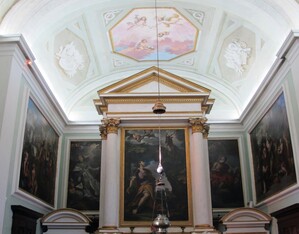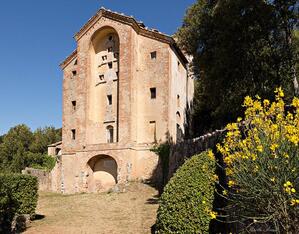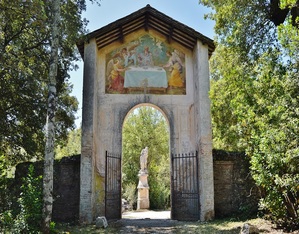Sacred and profane myths constitute the two polarities of this villa blending in the landscape of the Sienese countryside. A marvellous setting whose realization can be partly attributed to a Cardinal, the nephew of Pope Alexander VII.
The villa was first commissioned by Cardinal Flavio Chigi, a member of the rich and powerful Sienese family of bankers. Eventually the property passed to his nephew Bonaventura Chigi Zondadari (1652-1719), promoter of a widespread ascetic movement in the Sienese area. The construction works which started in 1676 and continued until 1716, were entrusted to the architect Carlo Fontana, a pupil of Gian Lorenzo Bernini. At the end of a long cypress-tree axis crossing the property, the symbols of sacred and profane Virtue face each other: on one side the statue of Hercules, hero of Good and a pagan symbol of Virtue, on the other the Romitoriohermitage with the Cross of Christ on its prospect, affording sweeping views of the entire complex and its beautifully preserved sorrounding landscape. In addition to the main rectilinear path, crossing a very ancient oak wood there is the winding circular Tebaide path (finalized by Bonaventura), which surrounds the villa and is adorned by statues of hermits attributed to the sculptor Giuseppe Mazzuoli, and aedicules depicting the stages of Christ’s life. Lord Lambton, owner of the villa since 1977, has restored the building and recently created an English style garden of herbaceous perennials.
Highlights

The chapel
By the villa there is a chapel dedicated to Saint Eustace who converted to Christianity after a vision of the Cross between the antlers of a deer. The presence of this chapel adds a spiritual touch to the woodland landscape in which Villa Centinale is set.

The Romitorio
The most visually remarkable element of the property, the Romitorio hermitage is set at the end of a long “holy stairway” connecting it to the villa. On its prospect, a large double cross is set in a colossal arched aedicule with the busts of the Evangelists at the ends of the crossbeams and a bust of Christ at the top of the vertical arm. Possibly planned during Flavio Chigi’s period, it was realised in Bonaventura Chigi Zondadari’s time.

The Tebaide
The long annular Station of the Cross path inside and outside the Tebaide, is marked by seven aedicules, dedicated to episodes of life of Christ, from the Nativity to the Deposition (and perhaps also the Resurrection). Also part of the decorative apparatus are statues of hermits (Saint Jerome and Saint John the Baptist guarding the entrances) and some animals carved in the rock.

The new garden
Lord Lambton’s sons have recently continued the work, creating a large new garden with a geometrical layout, with cone-shaped topiary and cypress trees creating a number of green rooms.
 Villa Cetinale
Contacts
Villa Cetinale
Contacts
Contacts
Telephone:+ 39 0577 311147
Other contacts::Fax: + 39 0577 311092
Address
Strada di Cetinale 9
53018, Sovicille (SI)
 Villa Cetinale
Opening times and prices
Villa Cetinale
Opening times and prices
Opening hours
The garden is open by appointment only.
Pricing
Visits to the garden are by appointment only.
 Villa Cetinale
How to get there
Villa Cetinale
How to get there
Address
Strada di Cetinale 9
53018, Sovicille (SI)
Latitude: 43.18248
Longitude: 11.121761
How to arrive by road
From Siena Ovest follow the SS73 towards Sovicille. Drive through Costafabbri, Costalpino and then Volte Basse. Immediately after the small village of Volte Basse, turn right towards Sovicille (SP37). Once in Sovicille, at the roundabout, take the third exit and turn right to continue towards Ancaiano (SP52). Just before entering the village of Ancaiano, turn right along a dirt road with signs for Cetinale and Celsa.
Additional directions
The Villa is 90 km from Florence airport and 105 km from Pisa airport.
 Villa Cetinale
Services/Accessibility
Villa Cetinale
Services/Accessibility
Services
Villa Cetinale offers on its website a online store .
Villa Cetinale offers visitors the opportunity to stay in its facilities.
- Stay in the Villa, offers many types of rooms and services. For the disabled, it is possible to book rooms and bathrooms on the ground floor.
- Stay at Casa Stella, recently renovated on the Cetinale estate, overlooking the Villa's garden.
- Stay at Casa Fabbri, the old farmhouse situated on the edge of the Montagnola Senese next to the Tebaide, or Sacred Wood.
- Stay at La Cerbaia, is a Tuscan farmhouse, nestled at the foot of the Montagnola Senese in the Cetinale Estate, halfway between Villa Cetinale and Romitorio.
If the Villa is rented, visits to the garden cannot take place.
 Villa Cetinale
Private events
Villa Cetinale
Private events
Villa Cetinale and its garden offer the possibility to organize many private events such as weddings and gala dinners.
 Villa Cetinale
Itineraries
Villa Cetinale
Itineraries
You could find the garden in these itineraries
 Favorite saving result
Favorite saving result
 Warning!
Warning!
You've have to sign up or sign in to add this element to your favorites.
